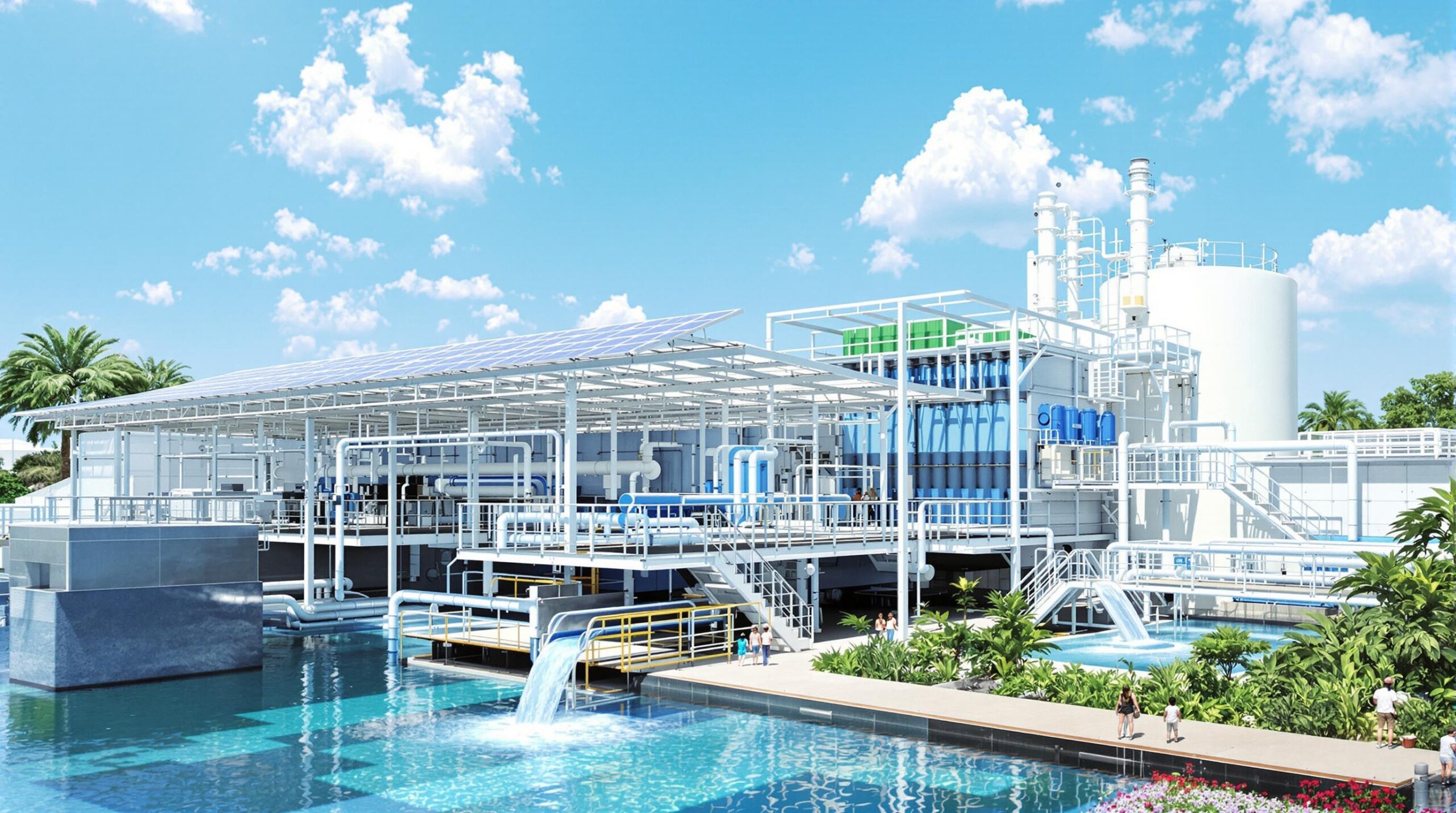Access to clean, fresh water remains a critical global challenge. Billions face water scarcity due to factors like population growth and climate change. Desalination, removing salt from seawater or brackish water, offers a potential lifeline. However, traditional methods often consume vast amounts of energy. They can also create environmental problems, such as the discharge of harmful brine. Exciting new technologies now promise more sustainable and efficient desalination. These innovations aim to provide fresh water without excessive ecological cost. This progress signals hope for water-stressed regions around the world.
The Urgent Need for Sustainable Solutions
Water scarcity affects communities and ecosystems worldwide. Growing populations place increasing demands on limited freshwater resources. Climate change exacerbates the problem through droughts and altered rainfall patterns. Many coastal areas sit beside abundant seawater but lack sufficient fresh water. Desalination is a logical solution in these locations. Yet, the standard approaches present significant drawbacks.
Conventional desalination plants require a significant amount of energy. This often relies on fossil fuels, contributing to greenhouse gas emissions. The process also generates highly concentrated saltwater brine. Disposing of this brine improperly can harm marine ecosystems. High operational costs further limit the widespread adoption of desalination, especially in developing nations. Therefore, the quest for sustainable desalination technologies is paramount. We need methods that are energy-efficient, environmentally benign, and economically viable. Such solutions are essential for a water-secure future.
A Look at Conventional Desalination Limits
Reverse Osmosis (RO) currently dominates the desalination market. This process uses high pressure to force water through semi-permeable membranes. These membranes effectively block salt ions and other impurities. RO technology has improved considerably over the decades. However, it remains inherently energy-intensive due to the high pressures required. Pushing water against its natural osmotic gradient demands significant power.
Another traditional method involves thermal desalination processes. Techniques like Multi-Stage Flash Distillation (MSF) boil seawater. The resulting steam condenses into fresh water. Thermal methods typically require even more energy than reverse osmosis (RO). They are often viable only when integrated with power plants providing waste heat. Both RO and thermal methods struggle with brine management. Finding sustainable disposal methods for large volumes of hypersaline water is a persistent challenge. These limitations highlight the critical need for innovation.
Breakthrough Technologies Changing the Game
Scientists and engineers are developing truly innovative desalination approaches. These efforts focus on reducing energy consumption and environmental impact. Several key areas show remarkable promise for the future of freshwater production. These breakthroughs could revolutionize how we obtain potable water from saline sources.
Advanced Membrane Materials
The heart of Reverse Osmosis is the membrane. New materials promise dramatic improvements over traditional polymer membranes. Graphene membranes, with their single-atom thickness, offer exceptional water permeability. This structure allows water molecules to pass through much more easily. Lower operating pressures may become feasible, resulting in significant energy savings. Carbon nanotubes exhibit similar potential for high water flux and salt rejection.
Biomimetic membranes represent another exciting frontier. These membranes incorporate aquaporins, proteins found in living cells. Aquaporins facilitate highly efficient and selective water transport across cell membranes. Researchers aim to replicate this natural efficiency in synthetic membranes. This could lead to desalination requiring much less energy.
Furthermore, developing membranes with anti-fouling or self-healing properties reduces the need for maintenance. Less fouling means fewer chemical cleanings and a longer lifespan for the membrane. This contributes to both environmental sustainability and cost reduction.
Harnessing Renewable Energy
Integrating desalination with renewable energy sources is a crucial step towards sustainability. Solar power offers a desirable option, especially in sunny, arid regions. Solar thermal desalination uses sunlight directly to heat and evaporate water. Advanced designs improve the efficiency of these solar stills. Photovoltaic (PV) panels can directly power reverse osmosis (RO) systems. The falling cost of solar PV makes PV-RO increasingly cost-effective. This combination allows for off-grid desalination operations in remote areas.
Wind power also presents opportunities for sustainable desalination. Coastal areas suitable for desalination often have strong wind resources. Wind turbines can provide the electricity needed to run reverse osmosis (RO) plants. Geothermal energy offers another potential source of clean power or heat. Utilizing diverse renewable sources reduces reliance on fossil fuels. This significantly lowers the carbon footprint of producing fresh water. Coupling desalination plants directly with renewable energy installations maximizes efficiency.
Exploring Alternative Processes
Beyond improving RO, researchers explore entirely different desalination mechanisms. Membrane Distillation (MD) is one such promising alternative. MD uses a hydrophobic membrane to separate heated saltwater feed from a cooler stream. Water vapor passes through the membrane pores due to a temperature difference. It then condenses as fresh water on the cooler side. MD can operate at lower temperatures than traditional thermal methods. It can utilize low-grade waste heat or solar thermal energy. This makes MD attractive for specific applications and hybrid systems.
Forward Osmosis (FO) operates on a different principle than reverse osmosis (RO). FO uses a natural osmotic gradient to draw water across a membrane. A highly concentrated “draw solution” pulls water from the saltwater feed. The diluted draw solution must then be treated to separate the fresh water. While separating the draw solution requires energy, FO operates at low hydraulic pressure. This potentially reduces membrane fouling compared to high-pressure reverse osmosis (RO). FO shows promise for pre-treating challenging water sources or in specialized applications.
Capacitive Deionization (CDI) offers an electrochemical approach. CDI uses porous electrodes to adsorb salt ions from water when a voltage is applied. Releasing the voltage regenerates the electrodes and produces a concentrated brine stream. CDI is particularly effective for treating brackish water with lower salt concentrations. It may require less energy than RO for these less saline sources. Continuous research aims to improve electrode materials and energy efficiency for CDI.
Innovative Brine Management
Managing the hypersaline brine produced during desalination remains a significant hurdle. New strategies focus on minimizing environmental harm and even extracting value. Zero Liquid Discharge (ZLD) systems aim to eliminate all liquid waste. These systems typically involve further concentration and crystallization steps. They produce solid salts and potentially recover valuable minerals, such as magnesium or lithium. While currently energy-intensive, ZLD represents a truly closed-loop approach.
Brine valorization seeks to find commercial uses for the concentrated brine. Extracted salts and minerals can serve various industrial purposes. This turns a waste product into a potential source of revenue. Less intensive approaches focus on more innovative brine discharge methods. Advanced modeling helps design diffusers that maximize the mixing of brine with seawater. This minimizes localized impacts on marine life near discharge points. Diluting brine with treated wastewater before discharge is another strategy under investigation. Sustainable brine management is crucial for the widespread acceptance of desalination.
Overcoming Hurdles to Implementation
Despite exciting technological progress, challenges remain. Scaling up promising lab-scale innovations to industrial levels requires significant effort. Pilot projects are crucial for testing performance and reliability in real-world conditions. The cost-effectiveness of new technologies must be proven against the continuously improving return on investment (ROI). Initial investment costs for novel systems can be high.
Material durability presents another concern. New membranes and components must withstand harsh saline environments for extended periods of time. Long-term operational data is needed to build confidence. Integrating different technologies into efficient hybrid systems also requires careful engineering. Combining FO as pre-treatment for RO, for instance, needs an optimized system design.
Finally, supportive policies and sufficient investment are crucial. Governments and international bodies play a vital role in funding research and demonstration projects. Clear regulatory frameworks can encourage the adoption of sustainable desalination technologies. Overcoming these hurdles demands collaboration between researchers, industry, and policymakers.
The Future Outlook for Fresh Water
The future of desalination appears increasingly sustainable. Breakthrough technologies offer significant pathways to reduce energy demand. They also provide better solutions for managing environmental impacts, like brine. Hybrid systems, which combine the strengths of different technologies, will likely become more common. For example, coupling MD with industrial waste heat sources looks promising. Using FO to pre-treat difficult water could enhance RO performance.
Artificial intelligence and machine learning will optimize plant operations. Predictive maintenance algorithms can minimize downtime and improve efficiency. We may also see a rise in decentralized, smaller-scale desalination units. These could serve remote communities or specific industrial needs powered by local renewables. Continued research will undoubtedly uncover even more efficient materials and processes. The drive towards sustainable desalination is strong, fueled by global water needs.
Conclusion: A Wave of Hope
Global water scarcity demands bold solutions. Sustainable desalination technologies offer a powerful tool in addressing this critical challenge. Innovations in membranes, renewable energy integration, alternative processes, and brine management are transforming the field. These breakthroughs promise to make desalination more energy-efficient, environmentally friendly, and cost-effective. While challenges exist in scaling and implementation, the pace of progress is encouraging. Continued investment and research can unlock the full potential of these technologies. Sustainable desalination represents a significant wave of hope. It provides a viable path to ensuring access to fresh water for future generations.


